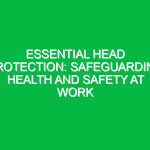Introduction
Personal Protective Equipment (PPE) serves as a fundamental component of health, safety, and environmental (HSE) management across various industries. Images of PPE play a crucial role in visual communication, aiding in the understanding and implementation of Safety protocols. They serve not only as instructional tools but also as reminders of the importance of Safety Measures in the workplace. This article delves into the significance of images related to PPE within the HSE domain, exploring their relevance, various types, and Best Practices for use.
The Role of Images in PPE Awareness
Images of PPE contribute significantly to Safety culture by enhancing awareness and understanding. For instance, visual representations of Safety Gear can clarify the proper use of equipment, making it easier for workers to recognize what is necessary for specific tasks. This is particularly important in industries such as construction, manufacturing, and healthcare, where the risk of injury is high.
Types of PPE and Their Visual Representation
Understanding the different types of PPE and their respective images is essential for creating an effective safety program. Below are some common categories of PPE, along with their uses and how images enhance comprehension.
- Head Protection: Hard hats are crucial in protecting against head injuries from falling objects. Images showing various hard hat types can help workers identify the appropriate headgear for their specific work Environment.
- Eye and Face Protection: Safety Goggles and face shields protect against chemical splashes and flying debris. Images demonstrating the correct and incorrect ways to wear these items can reinforce proper usage.
- Hearing Protection: Earplugs and earmuffs are necessary to prevent hearing loss in noisy environments. Visuals of both types can aid in selecting the right protection based on noise levels.
- Respiratory Protection: Masks and respirators are critical in environments with airborne contaminants. Images depicting various masks can help workers understand the right choice for specific Hazards.
- Hand Protection: Gloves come in various materials, each suited for different tasks. An array of glove images can help workers identify the best type based on their work conditions.
- Foot Protection: Safety boots protect against punctures and heavy impacts. Images that showcase different styles can assist in selecting appropriate footwear for various environments.
Best Practices for Using PPE Images
To maximize the effectiveness of PPE images in promoting safety, consider the following Best Practices:
- Contextual Relevance: Ensure that images are relevant to the specific environment and tasks being performed. For example, using images of construction helmets in a manufacturing setting may not convey the intended message.
- Clear Labeling: Images should be accompanied by clear labels and descriptions, detailing the equipment’s purpose and proper usage.
- Training Integration: Incorporate images into Training sessions to reinforce learning. Visual aids can enhance understanding, especially for those who may struggle with verbal instructions.
- Regular Updates: Keep images current by updating them to reflect new PPE technologies and Standards. This ensures that workers are familiar with the latest safety equipment.
Potential Hazards and Risks Related to Inadequate PPE Awareness
Failing to recognize the importance of PPE can lead to serious accidents and injuries in the workplace. Here are some potential hazards associated with inadequate PPE awareness:
- Increased Injury Rates: Without proper protective gear, workers are more susceptible to injuries, which can result in lost time and financial losses for companies.
- Legal Implications: Non-compliance with safety Regulations can lead to legal repercussions for employers, including fines and lawsuits.
- Lower Morale: A workplace that neglects Safety Measures can create an atmosphere of distrust and low morale among employees.
Real-life scenarios highlight these risks. For example, a construction worker who fails to wear a hard hat may suffer a severe head injury from a falling object. In another case, a healthcare worker exposed to infectious diseases without appropriate respiratory protection could contract a serious illness.
Regulations and Standards Governing PPE Usage
Numerous regulations and standards govern the use of PPE in various industries to ensure worker safety. Understanding these regulations is essential for compliance and protection.
Occupational Safety and Health Administration (OSHA)
In the United States, osha sets forth guidelines that outline the responsibilities of employers to provide appropriate PPE. According to OSHA standards, employers must conduct a hazard assessment to determine what PPE is necessary for specific job tasks. Images of PPE should reflect the standards set by OSHA, enhancing compliance and safety culture.
Personal Protective Equipment at Work Regulations 1992 (UK)
In the UK, the Personal Protective Equipment at Work Regulations mandate that employers provide suitable PPE to employees. This includes ensuring that images of PPE are accessible and clearly displayed in the workplace, helping to inform workers about their rights and responsibilities regarding safety equipment.
International Standards
Globally, various standards organizations, such as the International Organization for Standardization (ISO), provide guidelines for PPE. Compliance with these standards often requires employers to use images of PPE that meet specific criteria, ensuring that equipment protects against identified hazards effectively.
Actionable Insights and Guidelines for Implementing PPE Practices
To create a robust PPE program, organizations should consider the following actionable insights:
- Conduct Regular Training: Regularly scheduled training sessions that utilize images of PPE can enhance awareness and understanding of safety protocols.
- Implement Visual Safety Signage: Use images of PPE in safety signage throughout the workplace to remind employees of the necessary gear for different tasks.
- Encourage Reporting: Create an open environment where workers can report issues related to PPE use or availability without fear of repercussions.
- Engage Employees: Involve employees in discussions about PPE choices and improvements. Their real-world experiences can offer valuable insights into what works best on the ground.
Conclusion
Images of PPE play an indispensable role in promoting health, safety, and environmental standards in the workplace. By enhancing awareness, facilitating understanding, and ensuring compliance with regulations, these images contribute to a safer working environment. Companies that prioritize the use of effective visual aids in their safety training and daily operations not only protect their employees but also foster a culture of safety that can lead to greater overall productivity and morale.
As we move forward, the importance of PPE images cannot be overstated. They are not merely illustrations but vital components of a comprehensive safety strategy. Organizations must continue to innovate how they present and utilize these images, ensuring that every worker understands the critical role PPE plays in safeguarding their health and well-being.


